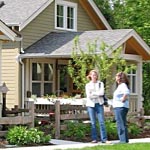
Finding a Home in a Pocket Neighborhood
Start your search by going to Real Estate site such as www.trovit.com and key in “Ross Chapin”. Most of the homes that come up will be individual houses, but on occasion you will find one in a pocket neighborhood. You might find an existing home for sale in a Seattle area pocket neighborhood by visiting The Cottage Company to see their list of homes.
Cohousing, a related cousin to pocket neighborhoods, are communities that are planned and managed by owner-residents who share a similar vision. Read more about them in Part Three of Ross’s book, and in the book, Cohousing: A Contemporary Approach to Housing Ourselves. In a recent blog essay by Ross, he discusses the similarities and differences between pocket neighborhoods and cohousing. Cohousing requires tremendous involvement by residents, but by the time everyone moves in, there is already a strong sense of community. Cohousing.org has directory of existing and forming groups around the country. Occasionally, we work with cohousing groups to design a site plan and coordinate with a developer.
Finding a Developer
To be clear, Ross Chapin Architects is not a developer. We take the lead design and planning, but building a pocket neighborhood requires the expertise of progressive developer.
For leads on locating a developer in your area, you might start by asking your city planner. They are not supposed to recommend any one over another, but they may be willing to give you a list and suggestions. Another lead is to Google “smart growth + (your city)” and contact the people or organizations that come up. Finally, check out The Congress for the New Urbanism, a national organization that fosters vibrant communities. Check their directory for local chapters and inquire into contacts there. Your city may also have a green-building association to contact.
When you find a developer, tell them your vision and interest. If they don’t know about pocket neighborhoods, share the Pocket Neighborhood website and RCA website, and show them Ross’s book. Contact Ross Chapin Architects for project worksheets of several of the pocket neighborhoods, which can serve as a helpful tool to explain the approach to others.
Gather Your Clan
Developers respond to potential buyers, especially if there is more than one. Talk with friends who might be interested in living in a pocket neighborhood. Host a discussion group, or potluck conversation about this possibility in your community. Start an online interest group.
Changing the Codes
Pocket neighborhoods are enabled (or not) by local zoning codes. Share the links above with your local planning official, as well as the link to our section on codes. They will tell you whether this type of innovative project is possible, and may be able to help you identify where potential parcels of land are located. If they do not know anything about pocket neighborhoods, your inquiry will get them thinking. Tell your story. Describe your interest and need. This is how change happens.
Creating Community Where You Live
Lastly, sometimes you don’t have to move anywhere to find what you want — you can create community where you live now. Check out this blogpost for ideas.

